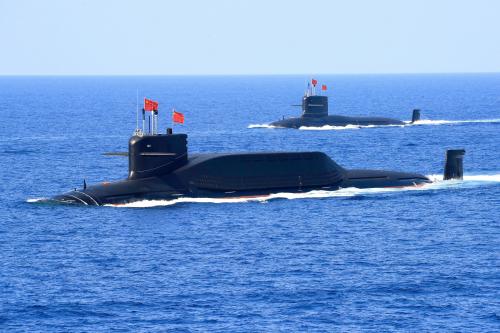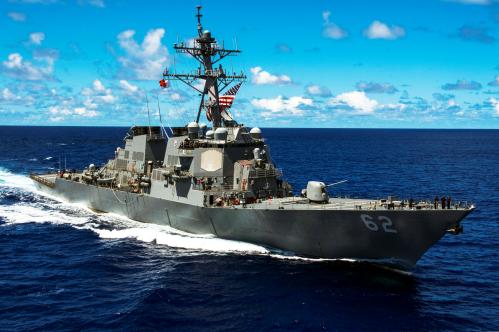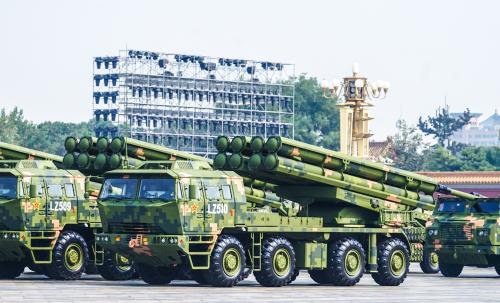As President-elect Joe Biden prepares to officially take office on January 20, 2021, he and his administration will face a number of near-term arms control and strategic policy challenges.
These challenges include: 1) extending the New START treaty with Russia; 2) finding a way to integrate China into a future arms control and strategic stability framework; 3) reviewing U.S. nuclear modernization and deterrence policy; 4) responding to the growing anti-satellite threat to U.S. and allies’ space systems; and 5) rebuilding the State Department’s arms control workforce. The Biden administration must make sure it starts off on the right foot.
Extension of New START
The fate of the New Strategic Arms Reduction Treaty (New START) with Russia is the most pressing near-term issue on the arms control and strategic policy agenda. New START is scheduled to expire on February 5, 2021, but can be extended for up to five years. The Trump administration made an attempt to negotiate a deal with Russia to extend the treaty before the November 3 U.S. presidential election. However, those efforts failed, and it will likely fall to the incoming Biden administration to determine whether to extend New START.
President-elect Biden has said that he will seek to extend the treaty. In a March 2020 essay in Foreign Affairs, he wrote: “I will pursue extension of the New START treaty, an anchor of strategic stability between the United States and Russia, and use that as a foundation for new arms control arrangements.” According to recent press reports, Biden’s key national security advisers have confirmed that the Biden administration would seek to extend the treaty.
The Biden administration will need to move quickly if it is to make this a reality, given that the treaty is set to expire just a few weeks after Biden’s inauguration. There are several steps the Biden team can take now.
First, when President-elect Biden has his first telephone conversation with Russian President Vladimir Putin, the two leaders should agree that the New START extension should be the number one priority on the bilateral agenda, and instruct their respective teams to move forward with an extension of the treaty immediately upon Biden taking office.
Second, though Senate approval is not required to extend New START, the United States and Russia will need to exchange diplomatic notes, which the Biden team should prepare during the transition period to share with Russian counterparts once Biden takes office. The team should also prepare a draft statement that would outline a way forward on bilateral arms control issues. Such a statement could outline goals and objectives like establishing formal U.S.-Russia strategic stability talks; addressing non-strategic nuclear weapons, integrating third parties like China into future arms control agreements; and incorporating emerging technological challenges, such as those in outer and cyber space, in future arms control agreement. And finally, as the Biden team moves forward on a New START extension, it should consult closely with Congress, especially members of the Senate Foreign Relations Committee. Early and sustained engagement with Congress could help build bipartisan support for the Biden administration’s longer-term arms control goals and objectives.
Bringing China into the fold
As I’ve written elsewhere, integrating China into a future arms control and stability framework is essential to the global arms control regime’s long-term viability. Although the Trump administration mishandled its diplomatic proposal to include China in U.S.-Russia nuclear arms control negotiations, its overarching objective of seeking to include China was strategically sound. Therefore, in the early months of the Biden administration, U.S. officials should develop an approach for a more substantive dialogue with China.
To begin, Biden should propose to Chinese President Xi Jinping that the United States and China hold bilateral discussions on the full range of arms control and strategic policy issues in early 2021. The purpose of this dialogue should not be to negotiate an arms control treaty, but to build trust and reduce the possibility of miscalculation and misperceptions. To be useful, this bilateral dialogue will need to include representatives from the key agencies and departments in both nations, especially the U.S. Department of Defense and the Chinese People’s Liberation Army.
To supplement bilateral talks, the U.S. and China should also seek ways to engage in a more robust dialogue with other established nuclear powers. U.S. officials previously advocated for discussing strategic stability within the group of five permanent members of the United Nations Security Council (China, France, Russia, the United Kingdom, and the United States), and Chinese officials participated. Senior Chinese officials continue to see the P5 as a useful venue for strategic stability discussions, with Ambassador Fu Cong (Beijing’s lead arms control official) saying in an interview with the Russian newspaper Kommersant: “We hope to make better use of this P5 mechanism so that we can have a proper platform to discuss all issues that affect global strategic stability.” These discussions could play a useful role in advancing nuclear risk reduction measures, but they would not replace the important bilateral dialogue.
Nuclear modernization and deterrence
The modernization of the U.S. strategic nuclear deterrent is another near-term challenge. The Biden administration faces a very different strategic reality than the last time Biden was in office as vice president. Indeed, the overall relationships with Russia and China have worsened significantly since then, and both are modernizing their nuclear forces. As the Office of the Director of National Intelligence has noted: “Russia will remain the most capable WMD [weapons of mass destruction] adversary through 2019 and beyond, developing new strategic and non-strategic weapons systems.” And the Pentagon’s 2020 annual report on Chinese military power states: “Over the next decade, China’s nuclear warhead stockpile—currently estimated to be in the low 200s—is projected to at least double in size as China expands and modernizes its nuclear forces.” Given these developments, ensuring the United States modernizes its nuclear forces to deter these threats remains a priority.
On the other hand, the current costs associated with modernizing the U.S. strategic nuclear program are estimated to be considerable. Indeed, in an October 2017 report, the Congressional Budget Office (CBO) estimated that the “2017 plan for nuclear forces would cost a total of $1.2 trillion from 2017 to 2046.” And in a subsequent January 2019 report, the CBO estimated that those costs will continue to grow. This comes at a time when defense budgets are likely to remain flat, and the Department of Defense will also need to re-capitalize its conventional military forces and invest in emerging technologies. As a result, the Biden administration must find a way to effectively deter states like Russia and China in a way that is fiscally sustainable over the long-term. This will likely require trade-offs.
Since the early 1990s, each U.S. administration has conducted a Nuclear Posture Review (NPR) that examined U.S. nuclear policy, strategy, and programs. However, as Lawrence Livermore National Laboratory’s Brad Roberts has written, given the evolving security environment — especially the more competitive relationships with Russia and China — and the decline of U.S. conventional military superiority, the United States may not be best served by conducting another NPR. Roberts writes that the new military problem for the United States is how to deter “regional conventional wars against nuclear-armed challengers like Russia, China, and North Korea, who oppose U.S.-backed regional security orders.” He writes: “The new military problem brings with it a requirement to rethink how to align nuclear and non-nuclear forces in a manner that supports our outer deterrence objectives and our political-military objectives if deterrence fails.”
One way to achieve this nuclear/non-nuclear integration — a challenge that Roberts and other analysts have explored — might be to embed nuclear issues in a broader Deterrence Posture Review (DPR). A DPR process could help the Biden administration determine the right set of military capabilities and policies — nuclear and non-nuclear — it requires to deter current and emerging threats in a fiscally-sustainable manner. Indeed, if nuclear weapons are ever used again, it is unlikely to be as a result of “a bolt out of the blue” nuclear attack, but the result of the escalation of a conventional conflict. Therefore, the best way to prevent a nuclear war may be by preventing conventional conflict from occurring in the first place.
And as a DPR would have significant geopolitical implications, it is critical that representatives from the U.S. State Department are active participants in the review. Furthermore, a DPR should include mechanisms to ensure close consultations with allies and partners throughout the review process.
Addressing the anti-satellite threat
Over the past decade, the threats to U.S. space systems from countries like Russia and China have continued to grow. Former Director of National Intelligence Dan Coats testified to Congress in 2019 that “Russia and China are training and equipping their military space forces and fielding new antisatellite weapons to hold US and allied space services at risk.” Indeed, potential adversaries understand how dependent the U.S. military is on outer space, so these trends are likely to continue for the foreseeable future.
Consistent with actions taken during the Obama administration, the Trump administration has pursued steps to increase the resiliency of U.S. space systems and enhance deterrence in outer space, including through the establishment of the U.S. Space Force, and the re-establishment of U.S. Space Command. Some progressive Democrats have called on the Biden administration to eliminate the Space Force. However, given the growing threat to U.S. and allied space systems, such a move would be unwise. Instead, the Biden administration should work to ensure that the Space Force improves the integration of space across the Joint Force; encourages further integration of U.S. allies and partners into space operations; and enhances the resiliency of our national security space systems. In addition to these military-related steps, the Biden administration should take steps to revitalize America’s space security diplomacy, which has largely been an afterthought during the Trump administration. A Biden administration should consider ways to expand space security consultations with allies and partners, and promote norms of behavior that can advance the security and sustainability of the outer space environment.
Rebuilding the State Department’s arms control workforce
The State Department’s arms control workforce has been under stress for some time due to problems associated with an aging staff and the inability to effectively recruit and retain younger talent. For example, a 2014 State Department Inspector General report on the Bureau of Arms Control, Verification, and Compliance states: “Forty-eight percent of the bureau’s Civil Service employees will be eligible to retire in the next 5 years, the second-highest percentage in the Department of State … Absent a plan to improve professional development and succession planning for the next generation of arms control experts, the bureau is at risk of losing national security expertise vital to its mission.”
Though many of the challenges associated with the arms control workforce pre-date the Trump administration, according to press reports, these trends have accelerated under its watch. As a result, the Biden administration will inherit an arms control workforce that has been hollowed out. A key priority for the incoming team must be to rebuild this workforce. Luckily, the Under Secretary of State for Arms Control and International Security has the authority under the Arms Control and Disarmament Act to hire technical arms control experts through an expedited process. In the near-term, the State Department should take advantage of this and other existing hiring authorities to help rebuild the arms control workforce. Over the longer term, it should work with Congress to determine whether new hiring authorities would help grow and maintain the arms control workforce.
Building a strong foundation
President-elect Biden will face an extremely complicated security environment when he takes office in January 2021. The future of arms control and strategic policy are likely to be among some of the most challenging issues. On arms control, the Biden administration will need to extend New START, find a way to integrate China into a future framework, and rebuild the arms control workforce. On the deterrence side of the equation, it will need to find a way to simultaneously modernize the U.S. nuclear deterrent, re-capitalize conventional forces, and invest in emerging technologies all at a time when defense budgets are likely to remain flat.
We should not underestimate just how difficult these challenges will be. However, if the Biden administration takes pragmatic steps early on, it could help build a strong foundation for achieving future progress in the arms control and strategic policy area.









Commentary
Starting off on the right foot: Biden’s near-term arms control and strategic policy challenge
December 4, 2020